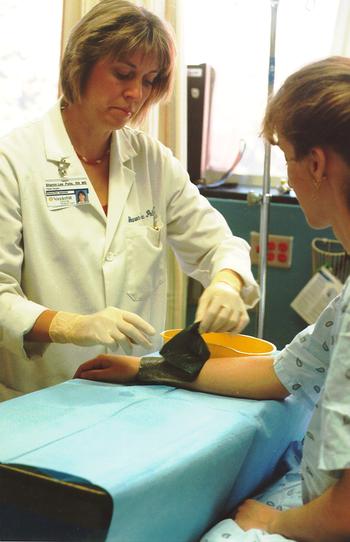Researchers investigating new ways to treat burns

Nurse Sharon Polis demonstrates one of the new types of burn treatments currently being tested at VUMC. Photo by Donna Jones Bailey
Vanderbilt University Medical Center researchers are investigating several new treatment options for burn patients.
The treatments range from new methods to relieve nausea to new types of dressings to a new biological dressing with the potential to help burns heal better.
"We are always looking for new and better ways to treat our burn patients and we believe these new treatments will help us do that," said Sharon Polis, M.S.N., R.N., clinical research specialist in Plastic Surgery.
The unit is conducting tests on four new treatments, all under the supervision of Dr. R. Bruce Shack, professor and chair of the Department of Plastic Surgery.
Of particular interest to Polis and her research colleagues is the drug ondanzetron. The anti-nausea and anti-vomiting drug has been used for several years for cancer patients undergoing chemotherapy, but Polis said efforts are now under way to expand its use.
"We believe ondanzetron can help reduce opioid-induced nausea that our burn patients experience during treatment and we think it will be very helpful."
The second study under way is testing a new type of burn bandage that has silver included in the dressing.
The anti-microbial barrier dressing can help reduce infection, Polis said, a very real threat to burn patients. Also, the new bandage is changed only every 24 hours, which helps reduce pain.
"The new bandage is off and on almost instantly," Polis said. "We take the old bandage off, wet another, and place it on the sking and then wrap the site. The usual treatment is to clean the skin, apply ointment, then wrap."
Polis said in this study, the time factor is part of the consideration.
"If it takes less time to clean the wound, it means less time for the nursing staff and less time for the burns to be exposed to air, which is very painful."
About 25 patients will take part in this study, Polis said.
The third study, looking at treatment of the donor site, was requested by the nursing staff, Polis said.
"When we treat burns, many times we do a split thickness skin graft. We take an area of normal skin, remove it and put it on the burned skin area. Basically, we are creating another wound, called the donor site. The nurses really wanted a better treatment option for the donor site."
Polis said the current method of treating the donor area is adequate, but could be improved.
"It helps with infection really well, but it's hard to see through the dressing to the wound to monitor healing. Sometimes moistness under the dressing becomes a problem and the donor site doesn't heal as well."
In this study, Polis said the burn unit will be trying out a new kind of temporary wound dressing.
"The new dressing is a bio-synthetic wound dressing constructed of a silicon film with a nylon fabric partially embedded into the film. Collagen, which helps stimulate growth, is also included in the dressing.
"With this, we can better see how the wound is progressing and patients have increased mobility with this dressing."
Polis said the staff will consider several factors when comparing the new dressing to the current method of donor site treatment.
"Does one hurt less? Does the patient feel they get a better approach with less pain because the dressing is not binding the skin as much and the wound is not bleeding as much?
"We really want to see how the patients feel about this," Polis said.
About 20 patients will participate in this study.
The fourth study deals with using a new artificial skin graft product to cover the burn area itself. The product consists of several layers of composite cultured skin, or CCS.
"Researchers take the foreskin from newborn babies, skin that would normally be discarded, and grow it in culture dishes. It is then placed over a matrix of a dressing."
Polis said this method does away with the need to take a patient's own skin autograft from a donor site to cover their burn.
"CCS is designed to stimulate the body to rapidly regenerate its own skin, resulting in less scarring, post-operative pain and wound contraction.
"We hope the use of CCS will help shorten hospital stays, reduce the number of additional reconstructive surgical procedures, limit the need for both physical and psychological rehabilitation and reduce the overall treatment costs."
Polis said there is less scarring when using the new artificial skin on burns.
"With this new product, the tissue grows up through your skin and takes on an almost normal appearance."













